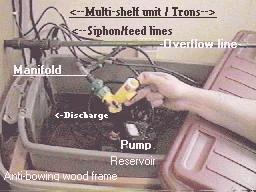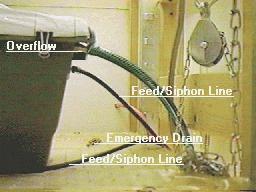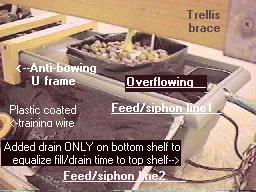for the do-it-yourselfer worried about leaks
The design shown here for filling and draining a tray is unique because the integrity of the bottom of the tray is never broken for drainage holes. This is the place where most concern exists over developing leaks. Instead, the solution is drained back to the reservoir, via the water pump, by the siphoning action naturally created in the feed line when the water pump shuts off. Because the feed line enters the tray near the top, not through a hole in the bottom, it eliminates the threat of leaks caused by the combined influences of gravity and water pressure created against the bottom of a tray when it's filled with water. For those concerned with taking the threat of leaks even farther, you will see some redundant measures described that can be applied to any hydroponic system in order to make it fail-safe.
This article will give you principles and ideas for a workable design, it will not give you a shopping list per se. It's hoped you will use your own ingenuity to apply the ideas to your particular situation, and to acquire materials that may differ slightly from the ones depicted here.
Container Overview |
Aside from the reservoir (the holding tank for your nutrient solution) you will see two other plastic containers being described here. One is a long planter box, the other is a bucket, they are used to contain the growing plants. Common terms generally associated with the function of these two hydroponic containers are the growing tray or bed, meaning a container to which the nutrient solution will be pumped then allowed to drain back into the reservoir. A growing tray may be any shape or size depending on the area it needs to fill with plant growth or the number of plants it will contain. Thus the bucket is a simple small one plant tray, and the planter box is a larger tray only because it's meant to contain more plants. The method used here to convert plastic containers to ebb/flow hydroponic growing trays is the same, and either a bucket or a planter box may be used in this article to illustrate the same point. Brand names commonly used are Rubbermaid and Tupperware, etc. but any container of similar design can be used.
The reservoir shown is a heavy duty Rubbermaid 25 gallon storage container which has a practical capacity of 23.5 gallons of water. It's inside another (50 gallon) cheaper, lighter weight Rubbermaid storage container as
a safeguard against spillage and the potential disaster of a reservoir leak. It supplies two growing trays which use Geolite
growing medium contained in grow bags. All feed lines going to trays are structurally fastened to each tray using methods
described in Part 2 for inserting snap-in fittings into plastic containers. A
reservoir is shown at the right. It should be noted, in hindsight, that the 23.5 gallons was not enough water volume to
supply the 16sq ft of growing area mentioned below without what I would consider unnecessary maintenance. See the Nutrient
Solution Management and Longevity article for more on reservoir sizing.
gallons of water. It's inside another (50 gallon) cheaper, lighter weight Rubbermaid storage container as
a safeguard against spillage and the potential disaster of a reservoir leak. It supplies two growing trays which use Geolite
growing medium contained in grow bags. All feed lines going to trays are structurally fastened to each tray using methods
described in Part 2 for inserting snap-in fittings into plastic containers. A
reservoir is shown at the right. It should be noted, in hindsight, that the 23.5 gallons was not enough water volume to
supply the 16sq ft of growing area mentioned below without what I would consider unnecessary maintenance. See the Nutrient
Solution Management and Longevity article for more on reservoir sizing.
 In the examples shown here, the main growing area is 2 shelves, one above the other (16 sq ft total). Each
shelf is 2x4 feet and has a lip of 1x2 wood screwed around the periphery of its upper surface. Fastened to the top of the
lip with staples is a single piece of vinyl flooring with a drain rigged at one corner where a 3" hole was drilled
in the shelf. At the 3" hole, a slightly undersized 1/2" hole was cut in the vinyl and a screw-in fitting for
1/2" tubing was installed by using a nut and rubber washer on each side of the vinyl to serve as a seal. The shelf
is graded for the drain to be the low spot. These are emergency backup drains in case a tray overflows or a fitting leaks
(hasn't happened yet after 10 years of constant use). The shelf drain, and the overflow hose for the trays, share a common
conduit that runs back to and discharges into the reservoir. It can be made of 1/2" poly tubing or 1/2" garden
hose whichever is most convenient for your situation. The drain runs back to the reservoir where the discharge handles
the overflow for two planter box trays and two bucket trays. With the pump delivering 5.1 psi, I would say this discharge
is just about the limit, adding more trays may need the 1/2" overflow hoses to feed into a larger discharge
line, for example 5/8" garden hose. While this may sound complicated, it's only the result of using fail-safe redundant
drains, without such fail-safe measures the 1/2" overflow hose simply needs be run directly to the reservoir.
In the examples shown here, the main growing area is 2 shelves, one above the other (16 sq ft total). Each
shelf is 2x4 feet and has a lip of 1x2 wood screwed around the periphery of its upper surface. Fastened to the top of the
lip with staples is a single piece of vinyl flooring with a drain rigged at one corner where a 3" hole was drilled
in the shelf. At the 3" hole, a slightly undersized 1/2" hole was cut in the vinyl and a screw-in fitting for
1/2" tubing was installed by using a nut and rubber washer on each side of the vinyl to serve as a seal. The shelf
is graded for the drain to be the low spot. These are emergency backup drains in case a tray overflows or a fitting leaks
(hasn't happened yet after 10 years of constant use). The shelf drain, and the overflow hose for the trays, share a common
conduit that runs back to and discharges into the reservoir. It can be made of 1/2" poly tubing or 1/2" garden
hose whichever is most convenient for your situation. The drain runs back to the reservoir where the discharge handles
the overflow for two planter box trays and two bucket trays. With the pump delivering 5.1 psi, I would say this discharge
is just about the limit, adding more trays may need the 1/2" overflow hoses to feed into a larger discharge
line, for example 5/8" garden hose. While this may sound complicated, it's only the result of using fail-safe redundant
drains, without such fail-safe measures the 1/2" overflow hose simply needs be run directly to the reservoir.
The planter boxes are Grossfillex brand (I believe a French company). It was chosen because of its size (8"Dx10"Wx37"L), dark gray opaque color, water tightness, and thick vinyl construction. Two simple "U" shaped supports were built from 1x2 wood to slip over the top to keep the sides from bowing out when it's filled with solution. Trays are covered with leftover wrap from rockwool slabs. Slab users may take this material for granted, just try to find a thin, opaque, plastic sheeting that's black on one side and white on the other, I'm sure it's made, but couldn't find any locally. The planter box trays fill and drain within 30-45 minutes when growing media is in the trays.
 Into each planter box can fit three 3 gallon grow bags filled with enough Geolite to be level with the rim.
If only one or two bags are used and much of the tray isn't filled with media, you can fill the void with a square gallon
jug filled with plain water and sealed. This displaces solution and allows faster filling and draining of the tray. The
feed/siphon lines are attached to the planter box, and use the same principle for fitting them to the planter as that described
for buckets in the Part 2. Each planter box, because of its larger size,
has 2 feed lines (one at each end). The smaller buckets each have one feed line and one 3 gallon grow bag. I use grow bags
because they fit the contours of the trays and make it more efficient to fill/drain them. They also allow me to remove
one plant without disturbing roots of adjacent plants. You can use net pots or any other suitable container for holding
the medium and plants.
Into each planter box can fit three 3 gallon grow bags filled with enough Geolite to be level with the rim.
If only one or two bags are used and much of the tray isn't filled with media, you can fill the void with a square gallon
jug filled with plain water and sealed. This displaces solution and allows faster filling and draining of the tray. The
feed/siphon lines are attached to the planter box, and use the same principle for fitting them to the planter as that described
for buckets in the Part 2. Each planter box, because of its larger size,
has 2 feed lines (one at each end). The smaller buckets each have one feed line and one 3 gallon grow bag. I use grow bags
because they fit the contours of the trays and make it more efficient to fill/drain them. They also allow me to remove
one plant without disturbing roots of adjacent plants. You can use net pots or any other suitable container for holding
the medium and plants.
Copyright © 1997-2004 pH